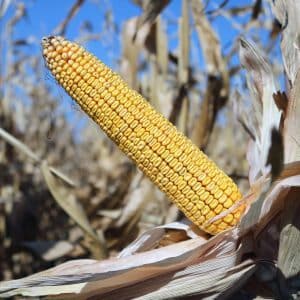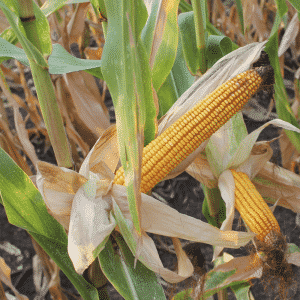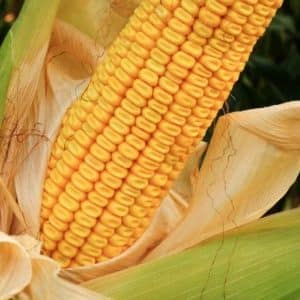Characteristics and description of corn seed hybrid Krasnodar 291 AMB
Corn is an ancient plant of the cereal family, native to Central and South America. Now it is one of the three grain crops in the world. It contains a large amount of useful vitamins and minerals. There are many varieties and hybrids of this cereal. The article will tell you about the hybrid Krasnodar 291 AMV: how to cultivate it, care for it, what are its advantages and disadvantages.
Corn Krasnodar 291 AMV
Hybrid Krasnodar 291 was bred at the Krasnodar Research Institute of Agriculture named after P.P. Lukyanenko. This is a modified tall crop of mid-early ripening type. The crop yield per hectare is 120 centners. The period of growth and maturation is about 3-3.5 months.
Product type
The hybrid is included in the State Register for cultivation for grain And silage for the Central, Central Black Earth, North Caucasus regions. In the classification of the International Organization for Food and Agriculture (FAO), it belongs to the group of medium-early type 290. The hybrid has yellow tooth-like grains.
Characteristics and description of the hybrid
Hybrid Krasnodarsky 291 tolerates drought well, adapts to different growing conditions, tolerates changes in air temperature and at the same time produces a high yield.
The indicators of the modified culture are:
- height up to 2 m;

- the cob is formed at a height of 60 to 80 cm;
- on the stem base grows up to 18 large-shaped leaves, has from 10 to 12 ground nodes between sections of the stem;
- the cob is cylindrical, with 14 rows of grains, the weight of an ear containing 1000 grains is 280-300 g;
- after threshing, grain yield is from 80 to 82%;
- the hybrid is resistant to smut and marsupial fungus, which causes stem rot (fusarium);
- the plant is drought-resistant, with a plant density of up to 60,000 plants per 1 hectare.
- the hybrid is bred on the basis of cytoplasmic male sterility of the seeds;
- eaten stewed, boiled, used as cattle feed;
- grown in the Southern Federal District (Krasnodar, Stavropol Territories, Republic of Adygea), Volga-Vyatka region.
Seed treatment and packaging
Corn seeds Krasnodarsky 291 are treated with Maxim XL fungicide. This drug protects the plant from diseases:
- root rot;
- stem rot;
- dusty smut;
- mold;
- ascochyta blight
Corn is packaged in 25 kg plastic bags (70,000 seeds in 1 package).
Features of sowing and growing
Corn is an unpretentious plant, so it does not require special planting methods. If you follow agrotechnical rules, the harvest will be rich. A dry and open plot of land that is not blown by strong winds is selected for this cereal crop.
It is better to plant the plant in soil where pumpkin, potatoes, peas, and beans previously grew. The soil for planting begins to be prepared in the fall, after the harvest. To reduce the acidity level of the soil, liming is carried out - 10 m² of land is treated with 2-3 kg of fluff lime. Dig up, adding a bucket of sand, peat, humus or manure to 1 m² of soil. Repeat digging up the soil in the spring - add potassium sulfate, superphosphate, urea (nitrogen fertilizer).
Recommendations for sowing:
- Before planting corn, the ground is loosened to get rid of weeds. It is better to grow corn from seeds in the southern regions. In other regions, it is worth using the seedling method.

- They begin to plant seeds when the soil temperature has warmed up to +10°C - in the last ten days of April or early May.
- It is better to germinate the seeds before planting in the ground. For this purpose, the grains are treated with special preparations (Regoplant, Biolan, Radostim) or a solution of manganese permanganate, placed in a jar (not covered with a lid). The seeds are poured with settled water, which is drained after 12 hours. The container with grains is covered with a cloth that does not allow air to pass through and is constantly moistened so that the seeds do not die.
- It is recommended to sow corn in well-warmed soil at a distance of 50x40 cm between rows, 15-20 cm between holes.
- Place 3-4 seeds in a hole 3-6 cm deep. When the plant has sprouted, remove weak shoots and leave 1-2 strong ones for greater resistance to lodging.
- It is recommended to plant the plant in 4 rows to ensure better pollination. If there is no cross-pollination, then this process is performed manually - the pollen is shaken into a bag and then sprinkled on the corn cob embryo. The procedure is repeated 3 to 4 times in the morning.
To prevent the plant from being weak, its crops are sprayed with growth stimulants (Biolan, Zeastimulin, Stimpo), chemicals intended for pest control and plant diseases by adding liquid fertilizers and microelements.
Fertilizing of the cereal crop is carried out 3 weeks after planting: use an aqueous solution of cow manure or bird droppings (1 liter of manure per bucket of water). Foliar feeding is carried out with a solution of urea - 1 tbsp. l. on a bucket of water.
Hybrid Krasnodar 291 does not require a lot of moisture. Water generously until a panicle forms - this ensures that the fruits will be juicy in the future. In August, watering stops.
Factors affecting corn ripening:
- region of growth;
- time of planting in the soil;
- maturation conditions.
Advantages and disadvantages of a hybrid
Hybrid Krasnodar 291 has advantages:
- resistant to a large number of pathogenic fungi and bacteria that cause stem rot, affecting leaves and ears;
- has large cobs that are easy to transport and last a long time are storedwithout losing its qualities;
- high yields in the Southern Federal District and the North Caucasus.
There are also disadvantages:
- susceptible to bacteriosis caused by the pathogen Vacillus bacterium;
- has no resistance to corn borer (hemp worm of the moth family).
Young ears of the hybrid Krasnodarsky 291 are stored for no more than 3 weeks in a cool room, with a storage temperature of 0 °C. If the temperature rises, then their taste is lost.
Storage and use
Proper storage of corn means preserving a large amount of nutrients and taste. Gardeners who have extensive experience in growing this crop advise storing this cereal crop not as grains in jars, but as cobs. There are 4 ways to store corn on the cob.
In the freezer
Storing this way extends the shelf life of the fruit, but the limit is 1.5 years. Thaw the cobs gradually, at room temperature. It is not recommended to pour hot water on it - it will affect the taste of the corn.
Before placing corn in the refrigerator, we recommend:
- Prepare 2 small containers, pour very cold water into one container, boiling water into the second;
- peel the cobs from leaves and fibers and soak alternately in cold and hot water (2-4 minutes each), the procedure is repeated several times;
- Place the corn on a napkin and let dry at room temperature;
- Wrap the prepared cobs in plastic wrap, place in containers and store in the freezer.
Dry
Only ripe corn is stored in this way and for no more than a year. It is cleaned of some leaves and tendrils so that it does not spoil quickly. The cobs are hung in the open air. At temperatures below +10°C, the fruits are brought indoors and dried in well-ventilated rooms so that the penetration of sunlight is maximum - in the veranda or attic. This method well preserves the integrity of the grains from which corn porridge is prepared.
Canning cobs
A method in which fruits are preserved for a long time: from 2 to 3 years, if the rules of sterilization are followed. Before sealing corn in jars boil, remove from the water, wrap in cling film and place in the refrigerator for 3 days. This method preserves the taste and juiciness of the corn kernels.
Canning corn kernels
First, the grains are placed in a pre-sterilized jar and filled with warm boiled water (salt is added to taste). Then the containers are closed with nylon lids and placed in the basement (cellar). After 2-3 days, the jars are lifted from the cellar, water is added, and they are lowered for another 5 months. Housewives use this canned corn in salads.
How long does it take to cook corn on the cob?
The time required to cook the cobs depends on the stage of ripening at which they were picked.
Fresh, young corn has a light yellow tint to the cob - it is cooked for 15-20 minutes after the start of boiling.
For cereals with dark grains, the cooking time is from 40 minutes to 1.5 hours (depending on the size of the cob and their quantity in the pan). In order for the corn to cook well, it is completely immersed in a container of water and covered with a lid. Readiness is checked by the grain: if it can be easily pierced with a match, then the product is ready for consumption.
Where can I buy
The Krasnodar 291 hybrid is sold in different regions of Russia where this crop is grown - in the Krasnodar, Stavropol Territories, and Rostov Region. The cost for one planting unit ranges from 2100 to 3000 rubles.
Reviews
We bring to your attention several reviews from experienced farmers.
Alexey, Art. Bryukhovetskaya, Krasnodar region: “I have been sowing the hybrid Krasnodar 291 for several years. These are grains of excellent quality that give a high yield. All seeds are the same size. There is no special care - weeding, hilling, irrigation. Very tasty boiled cobs.”
Taisiya, Rostov-on-Don: “Several years ago the summer was dry. And I didn’t expect that my Krasnodar 291 could withstand such heat. But the grains that were watered on time did not die. The harvest was rich, we ate the pleasant-tasting crop with pleasure, and also preserved 20 jars.”
Victor, Dzhankoy: “A well-adapted cereal. In no way inferior to imported varieties. The yield is high - no less than 102 centners per hectare for several years. The manufacturer gives recommendations to increase yield.”
Conclusion
Krasnodar 291 AMV is one of the best hybrids that quickly adapts to weather conditions, is not susceptible to many plant diseases, and has high yields. It is nutritious and good for health, as it contains valuable vitamins and microelements.